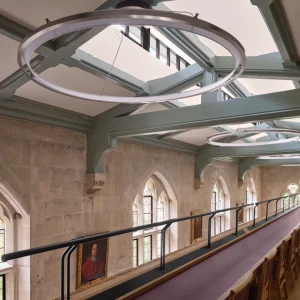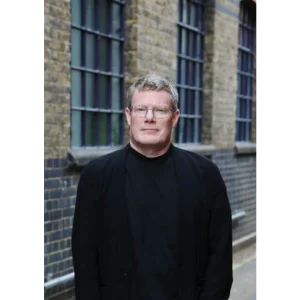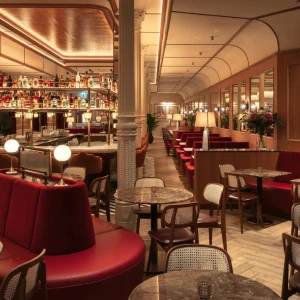
This month sees the opening of a remarkable exhibition at the National Maritime Museum in Greenwich in London by United Visual Artists. For the show, High Arctic, the new Sammy Ofer Wing is transformed into an abstract arctic landscape by the designers and offering an immersive experience that celebrates the unique landscape of the Svalbard archipelago of northern Norway.
UVA has a history of creating installations that test the boundaries between physical and digital environments. The company was founded in 2003 by Matt Clark, Chris Bird and Ash Nehru and is now 17-strong, employing a mix of designers, technicians and programmers.
The company was invited to design the opening event at digital art gallery La Gaîté Lyrique in Paris, which saw 18,000 visitors in five days visit the show and has received acclaim for its installations Chorus at the Wapping Project and Speed of Light at the Bargehouse on London’s South Bank.
UVA will inaugurate the new wing of the NMM, it is a prospect that excites special exhibitions senior project manager Matthew Lawrence. ‘We have never had a gallery for temporary exhibitions before, or a space so flexible’. says Lawrence. ‘We really hope to attract new audiences, we are blessed with the amazing gift of architecture by Inigo Jones and Christopher Wren, but that comes with baggage. The new wing will change what people expect of the museum’.
Upon winning the commission, Matt Clark travelled to the Arctic with the charity Cape Farewell which takes artists, designers, scientists, writers and academics above the Arctic Circle to teach them about the beautiful but threatened landscape, hoping that they will then educate others based on their first-hand experience. Such visitors have included Ian McEwan, Antony Gormley, Jarvis Cocker and Rachel Whiteread. ‘The sense of scale was breathtaking, disorientating even,’ says Clark. ‘We were told that glaciers that have taken 55,000 years to form will no longer be there when our children are in their teens.’

Having visited the landscape and having learned about the harsh but fragile environment, Clark had to set about coordinating the skills of UVA to create an installation that could relay his experiences. ‘There’s almost an apathy about climate change at the moment,’ he says. ‘The exhibition could not be a science lesson, people would have to get emotionally involved before you hit them with the science and facts.’
Lawrence concurs. ‘Most people don’t expect digital exhibitions to be emotive, but it was clear we needed to express to people what they stand to lose rather than banging them over the head with what they should be doing,’ he says.
UVA has responded with an exhibition set 100 years in the future, but which tracks back 2,500 years to the Greek navigators who first explored the Arctic Ocean. The 800sq m space is filled with 3,000 wooden plinths of varying heights, each one a monument to part of
the landscape. This physical environment is overlaid with digital information that will be revealed by the visitor shining a UV light on to the monuments and floor. ‘There is not a linear narrative to the exhibition,’ says Clark, ‘The Arctic is a hyperreal environment and
this is an abstraction of that. We are consciously avoiding the “Imax experience” and providing an environment which visitors can explore and discover.’

The installation has been extensively modelled both physically and digitally, using UVA’s in-house software d3. ‘The monuments themselves we first designed using Lego,’ says Clark, ‘and the final wooden columns that make up the landscape are 10 times larger than the original blocks. These are arranged in the underground exhibition space, which is darkened for the purposes of the exhibition, and the whole landscape is reflected in mirrored surfaces covering each wall, providing an implied extension of the landscape’.
The wooden monuments are arranged in the space in a grid pattern. Their heights are determined by a landscape mapped and then translated to represent peaks, ridges and gullies. The grid dissipates to allow projections from cameras suspended from the ceiling into a digital ‘pool’. Each of the 10 digital projections contains a seascape with fragments of icebergs and a soundscape that is revealed by visitors’ movements as well as their interacting with the physical landscape created by the monuments.

The visitor reveals the information by shining a UV light across the installation. This light also reveals a text by English poet Nick Drake, who travelled on the expedition with Clark. ‘We have never worked in an institution like the NMM before,’ says Clark, ‘We had to work out how to engage everyone from a five year-old to an eighty year-old.’
High Arctic is a bold venture for both the NMM and UVA. The museum sees the exhibition as the first in the series of shows about expeditions and maritime voyage. For UVA it is the first time it is marrying its technical expertise to generate a response beyond the abstract, as exhibition designers rather than artists. This brave move by both parties could set the standard in exhibition design in London for the coming years.
High Arctic at the National Maritime Museum, Greenwich -14 July 2011–13 January 2012





